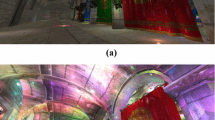Abstract
Recently, the performance of many-light algorithms, where thousands of light sources are used to compute the lighting in a scene, has improved so much that they have reached the realm of real-time rendering. In general, the algorithm that is considered “best” is the one that is the fastest in terms of time per frame. Given that power efficiency may become or already is one of the most important optimization factors for both hardware and software vendors for graphics, we take a different route and instead measure both energy usage per frame and frame time for a number of popular many-light rendering algorithms on an Intel Iris Pro. We use Pareto frontiers for each configuration to examine the possibilities for trade-offs between rendering time and energy consumption. Furthermore, we examine the optimal algorithms at each configuration, and are able to draw generalized conclusions on when each algorithm is most efficient. We also record several other statistics on the algorithms, e.g., bandwidth, and are able to draw further conclusions with regard to energy consumption.










Similar content being viewed by others
Explore related subjects
Discover the latest articles, news and stories from top researchers in related subjects.Notes
For 2048 light sources and more, forward with Z-prepass is not rendered and thus only three algorithms are available. For fewer lights, all four algorithms are available.
References
Akeley, K.: Reality engine graphics. Proc ACM SIGGRAPH 1994, 109–116 (1993)
Andersson, J.: Parallel graphics in frostbite: current & future. In: Beyond Programmable Shading (SIGGRAPH course) (2009)
Balestra, C., Engstad, P.K.: The technology of uncharted: Drake’s fortune. In: Game Developer’s Conference (2008)
Burns, C.A., Hunt, W.A.: The visibility buffer: a cache-friendly approach to deferred shading. J. Comput. Gr. Tech. 2(2), 55–69 (2013)
Dachsbacher, C., Kr̄ivánek, J., Has̄an, M., Arbree, A., Walter, B., Novák, J.: Scalable realistic rendering with many-light methods. In: Eurographics Symposium on Rendering, pp. 23–38 (2013)
Esmaeilzadeh, H., Blem, E.R., Amant, R.S., Sankaralingam, K., Burger, D.: Dark silicon and the end of multicore scaling. In: 38th International Symposium on Computer Architecture, pp. 365–376 (2011)
Fatahalian, K., Boulos, S., Hegarty, J., Akeley, K., Mark, W.R., Moreton, H., Hanrahan, P.: Reducing shading on GPUs using quad-fragment merging. ACM Trans. Gr. 29, 67:1–67:8 (2010)
Harada, T., McKee, J., Yang, C.J.: Forward+: bringing deferred lighting to the next level. In: Eurographics short papers, pp. 5–8 (2012)
Johnsson, B., Akenine-Möller, T.: Measuring per-frame energy consumption of real-time graphics applications. J. Comput. Gr. Tech. (JCGT) 3(1), 60–73 (2014)
Johnsson, B., Ganestam, P., Doggett, M., Akenine-Möller, T.: Power efficiency for software algorithms running on graphics processors. In: High Performance Graphics, pp. 67–75 (2012)
Keckler, S.W., Dally, W.J., Khailany, B., Garland, M., Glasco, D.: GPUs and the future of parallel computing. IEEE Micro 31(5), 7–17 (2011)
Keller, A.: Instant radiosity. Proceedings of the 24th Annual Conference on Computer Graphics and Interactive Techniques. SIGGRAPH ’97, pp. 49–56. ACM Press/Addison-Wesley Publishing Co., New York (1997)
Koduri, R.: “Power” of realtime 3D rendering. In: Beyond Programmable Shading (SIGGRAPH course) (2011)
Lauritzen, A.: Deferred rendering for current and future rendering pipelines. In: Beyond Programmable Shading (SIGGRAPH course) (2010)
Lauritzen, A.: Intersecting lights with pixels: reasoning about forward and deferred rendering. In: Beyond Programmable Shading (SIGGRAPH course) (2012)
Mochocki, B., Lahiri, K., Cadambi, S.: Power analysis of mobile 3D graphics. In: Design, Automation and Test in Europe, DATE ’06, pp. 502–507 (2006)
Olsson, O., Assarsson, U.: Tiled shading. J. Gr. GPU Game Tools 15(4), 235–251 (2011)
Saito, T., Takahashi, T.: Comprehensible rendering of 3-D shapes. In: Computer Graphics (Proceedings of ACM SIGGRAPH 90), pp. 197–206 (1990)
Shebanow, M.: An evolution of mobile graphics. In: Keynote talk at High Performance Graphics (2013)
Vatjus-Anttila, J.M., Koskela, T., Hickey, S.: Effect of 3D content simplification on mobile device energy consumption. In: International Conference on Making Sense of Converging Media, pp. 263:263–263:268. ACM (2013)
Walter, B., Alppay, G., Lafortune, E., Fernandez, S., Greenberg, D.P.: Fitting virtual lights for non-diffuse walkthroughs. Proc. ACM SIGGRAPH 1997, 45–48 (1997)
Author information
Authors and Affiliations
Corresponding author
Rights and permissions
About this article
Cite this article
Johnsson, B., Akenine-Möller, T. A performance and energy evaluation of many-light rendering algorithms. Vis Comput 31, 1671–1681 (2015). https://doi.org/10.1007/s00371-014-1046-y
Published:
Issue Date:
DOI: https://doi.org/10.1007/s00371-014-1046-y




